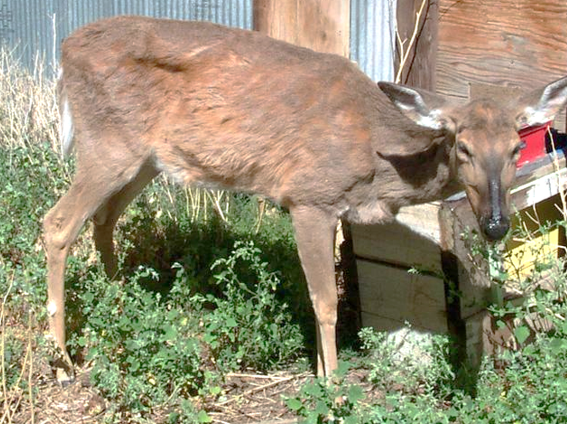Ken Baker: Chronic Wasting Disease in deer is here in Ohio, has surprising source

Kurt Vonnegut’s fourth novel, "Cat’s Cradle" (published in 1963), revolves around a fictional compound called Ice-nine, a chemically altered form of water that is not only solid at room temperature but has the unique ability to turn any bit of ordinary water it happens to touch into more Ice-nine.
Imagine what would happen if just one molecule of Ice-nine were to somehow plop into the sea. Vonnegut imagined it.
Chronic Wasting Disease, CWD, is a fatal disease of Cervids (deer, moose, elk, caribou). As such, it is a common topic of discussion among white-tailed deer hunters and wildlife biologists at this time of year. It’s worthwhile discussing the prevalence of CWD in deer populations, and how concerned we ought to be about the disease. I’ll get to some of that.
Ohio deer gun season: Hunters scramble to find meat processors amid butcher shop labor shortage
But I’d like to first examine the unexpected source of the disease. It’s not caused by a bacteria, virus, fungus, or parasite but by a rogue protein. And in a startling example of science-meets-fiction, Vonnegut’s Ice-nine provides a useful shoehorn into explaining how it works.
What is Chronic Wasting Disease, CWD?
CWD belongs to a group of diseases called Transmissible Spongiform Encephalopathies (TSEs), or Prion Diseases. Prion-proteins are found on cell membranes throughout the body (of both humans and animals). In their usual three-dimensional shape, it’s thought they may play useful roles in binding cells together and inter-cell communication, especially in neurological tissues, but their function(s) remains an open topic of research.
They’re not a problem in their “usual” three-dimensional shape.
But under extremely rare circumstances (that no one understands) a perfectly good prion-protein misfolds into a bad, abnormal 3-D shape referred to as a prion. This misfolded protein, astonishingly, now imitates Ice-nine in that any prion that bumps into a normal prion-protein, causes it to change its shape and become a prion.

To recap, very rarely a perfectly good prion-protein within some unfortunate individual deer misfolds (for God knows what reason) into a prion, and that prion then starts a chain reaction by causing other prion-proteins to morph into prions.
Ohio deer gun season: Harvest numbers in 2021 will be hard-pressed to match last year's
Over time, as more and more prions form, they clump together creating all manner of problems throughout the body, but especially in the brain and spinal cord.
Once CWD has gotten a toehold within a given deer, it typically spreads from one individual to another through contact with prion-containing body fluids (saliva, blood, urine) or by consumption of water or foods that have been contaminated by such fluids. Unfortunately, prions can remain infective outside of an animal for a long time.
Chronic wasting disease gets its name from one of the symptoms an infected deer shows in latter stages of the illness — drastic weight loss (wasting) — along with stumbling, listlessness, and lack of fear among other infirmities.
Although CWD is always fatal, it typically takes at least 16 months for symptoms to appear. This means that most infected deer cannot be distinguished from uninfected ones by appearance or behavior, which is one reason the Ohio Department of Natural Resources recommends wearing gloves when field dressing or butchering a deer and to minimize contact with the brain and spinal cord.
Thankfully, the CDC reports there is no strong evidence for the transfer of CWD to humans or livestock. In fact a University of Wyoming study found no evidence of the disease in cattle that had been housed for 10 years with CWD-infected deer.
Where is CWD found in wild deer populations?
The first cases of CWD ever seen were discovered in a white-tailed deer population housed in a Colorado research facility in the late 1960s, and it was first seen in free-ranging deer in 1981. As of November 2021, the USGS has reported it in wild populations of deer and elk from 26 states and three Canadian provinces.
The CDC observes that the nationwide incidence of the disease in free-ranging deer is relatively low, although in certain areas where the disease is well-established, infection rates can exceed 10%. Ohio is a relative newcomer to this unwelcomed party.
The first cases of CWD in Ohio were discovered in 2014 in a privately owned hunting preserve in Holmes County, after which the entire herd was destroyed. Since then, 25 deer on four other private facilities in Holmes and Wayne Counties have tested positive, but none in free-ranging deer until December 2020.
At that time, tissue samples from a mature buck shot on private property in Wyandot County tested positive for the disease — the first positive result in 30,000 tests since ODNR began routine surveillance for CWD in 2002.
In January 2021, a second case was found in a yearling doe harvested during a controlled hunt in Killdeer Plains Wildlife Area, less than two miles from where the first deer was taken. In response, ODNR implemented a Disease Surveillance Area involving intensive monitoring for at least three years in all of Wyandot and parts of Hardin and Marion Counties.
Check out ODNR’s Chronic Wasting Disease (Deer) web page for additional insights on the disease and hunting in Disease Surveillance Areas.
Ken Baker is a retired professor of biology and environmental studies. If you have a natural history topic you would like Dr. Baker to consider for an upcoming column, please email your idea to fre-newsdesk@gannett.com.
This article originally appeared on Fremont News-Messenger: Chronic Wasting Disease: What deer hunters in Ohio need to know
